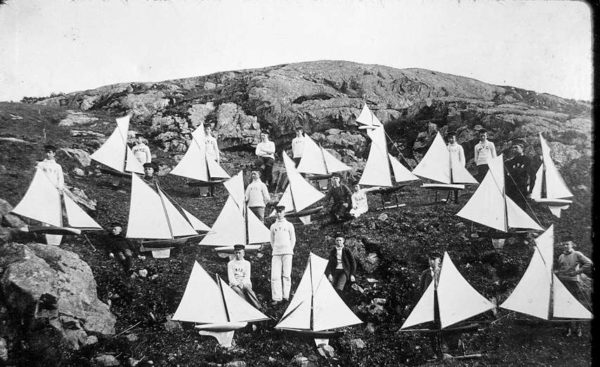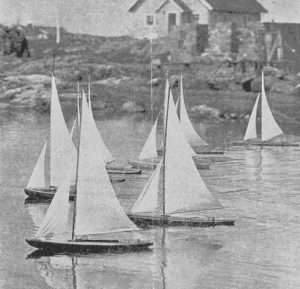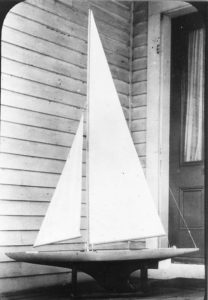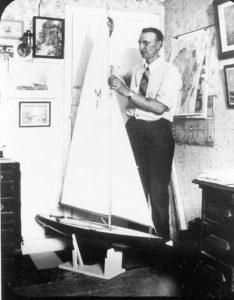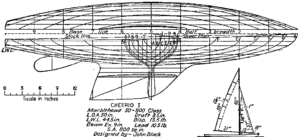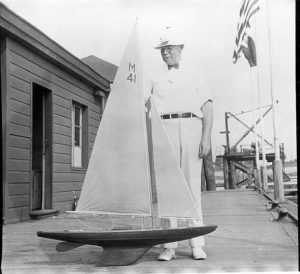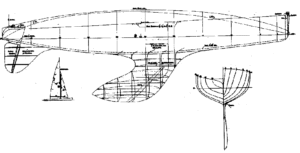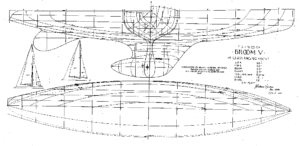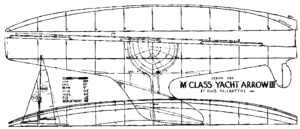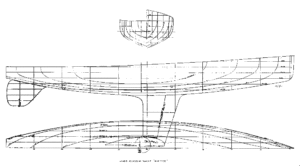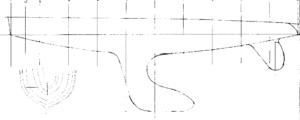History of the Marblehead Class
The Marblehead club was always a bit of a maverick in model yachting circles because it was large enough (70 members in 1930) to support classes of its own. Throughout the 1920s a very popular local class was the one originally suggested by the full-scale designer L. Francis Herreshoff: 450 in2 of sail area and no other restrictions.
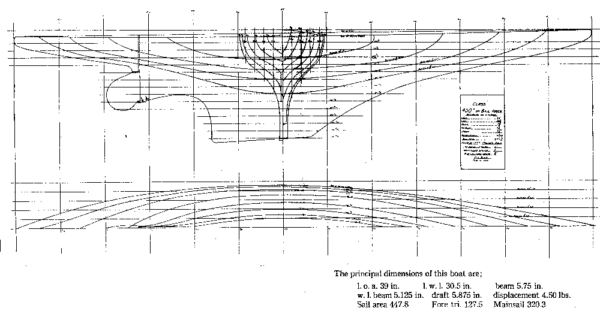
The plans shown here are for a design by C.W. Sweet. LWL 30.5 in, LOA 39 in, Displacement a mere 4.5 lb.
The 450 class, like other classes with no hull restrictions, lead to long, handsome “greyhound” shapes with extreme overhangs.
In 1930 Roy Clough, then commodore of the club, proposed a new class of larger boats. The first published reference we have is from Model Yachting for Oct–Nov 1930:
The 450 class has been so popular, with so many boats racing in it at Marblehead, that a larger sail area class has been started there. These boats must be 50 inches on deck. At first it was proposed to carry 700 sq. in. of sail, but after trying one out with 795 the question as to whether the sail shall be increased to 900 or 1000 sq. in. is to be brought up at a meeting of the club.
The result, of course, was that the sail area was settled at 800 in2, and the single most popular class in the history of model yachting was launched. Called variously the “Marblehead,” “50/800,” or “M” class, it had at one time over 1000 registered boats. The class became a national class in the US in 1932 and an international class in 1937. There were many reasons for its popularity: the size of the boat made for a good sailing model in all kinds of weather and was still (by design, it was rumored) small enough to fit in the back seat of a car. The simplicity of the rules contrasted with the other classes of the day, which required extensive measurement to determine whether a boat was legal.
In 1936, Roy Clough wrote how the Class was inspired:
I would now like to tell you how this class came into existence. The idea of building a boat of this size came to me suddenly one Sunday morning when my club was racing the old 450 square inch sail area class. Looking out on the pond, I was all at once conscious that although the class was limited to 450 square inches of sail we had a real ‘mongrel’ class of boats. Boats of all sizes, from 30 to 45 inches long; regular keels, fin keels, overhanging rudders, and boats anywhere from five to ten inches wide all belonged in the same class! I went home that Sunday morning and drew my dream boat in profile and sail plan on an old barn door. Different members of the club came to see it and were very favorable, so after drawing it up on paper and then building the boat, the interest began to increase, and soon there were twelve boats being built from that plan, each with a few individual changes.
From that time on, our membership began to increase, and we had to hire larger quarters. New clubs seemed to spring up overnight, and things started to boom for the Marblehead class. Later the design was officially adopted by the Model Yacht Racing Association of America, and the greatest model yacht building boom ever seen in this country was under way. Clubs and trophies began to appear as if by magic, and at the present time the most sought-after trophy is the ‘Marblehead Perpetual Challenge Cup’ which was won this year by the Jersey City Model Yacht Club. The Heisler Cup, which was given by Mr. Charles Heisler of Rensselaer, N.Y., is another beautiful prize. This cup is held by the Red Bank Model Yacht Club. Another trophy, a sterling silver bowl, which was won last year by Mr. Frank Goodwin of the Marblehead Yacht Club, is the Chester I. Campbell Cup, which was given by the estate of the late Chester I. Campbell. The winner of this cup holds it for one year and also receives a replica to keep. There are also large regattas held each year by other clubs at which there will be from 50 to 60 models. One of these events is the National Championship Races of the Marblehead 50/800 class, which will be held this year in Warinanco, New Jersey.
Little did anyone who saw the first profile drawing on the old barn door think that it was to be the forerunner of the largest model yacht class in the world today.
And now, to make the joy of 50/800 fans complete, I have this week received notice from the Model Sailing Club, a department of the German Sailing Club, that the Marblehead 50/800 class has been accepted in Germany because they ‘…believe that this class will render very nice and useful boats with a simple formula which are not difficult to build and which besides the reason of their small size are handy …’ An accompanying notice gave word that they are to hold an International Race at Hamburg at the end of the Olympic Games. One of the two yacht classes selected for the race is the Marblehead 50/800, and this country will be invited to send two boats to the competition. Eight other countries have also been invited to participate.
From the small beginning on the old barn door has come the most popular class of yachts the world has ever known; after blanketing our country, it has spread to foreign lands, and is still growing.
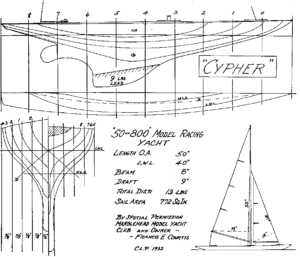
In 1932, the Marblehead club issued a challenge for M class boats, and Cypher was the successful defender. She is typical of “first generation” M boats in that she has a fair amount of overhang at bow and stern and thus retains a “yacht-like” appearance. This was all to change rapidly under the pressure of competition.
John Black’s Cheerio I won the first international M class race held in Berlin in conjunction with 1936 Olympics. The design is interesting in that it attempts to maximize waterline length and still maintain a shape reminiscent of her bigger sisters.
Cheerio later became famous with the publication of Black’s 1939 textbook Yachting with Models, and many copies of her were made. By that time, however, the design was no longer competitive; the snub nosed, vane-steered, high-rigged boats had come on the scene.
A. R. Lassel’s Sun-Kiss dominated the races of the 1940s. She was an example of what could be called the “third generation” of M boats. All pretense of “yacht-like” lines is gone, and the waterline length is carried as far as the rules will allow.
Here is her designer’s description, which accompanied the publication of her plans in Model Yachting Monthly for September of 1945:
The “Sun-Kiss” design shown in the MYM supplement stems from “Faithful” and “Gurgles”, The 1937 and the 1941 National M-Class champions, and from “Roschana”, runner-up in 1937. Ted Thorsen re-drew the lines of these yachts to conform to those of warships having a speed that produces the constant 1 in the speed-length formula. Hence, an M-Class yacht should make 2.04 naut. miles per hour when a 500′ warship makes 22.5.
She is not giving away any potentialities due to water-line length, has powerful sections and a flat chine line. Her lateral plane is more than adequate, so that, if wetted area be considered more important than dynamic balance, the width of the skeg may be reduced. On the “Sunmaid”, the last year’s National Champion, the skeg is a mere strut. The keels of Paul Collet’s “Sunmaid” and How’d Curry’s “Sunapee” weigh 13 lbs. and J. McKinney’s “Vagabond” and Dr. Peal’s models from this design weigh 13.5.
The design of the keel is the result of an observed phenomenon in towing 50-inch models of different keel designs at about twice the normal speed. When the junction of the keel with the hull was rather thick, and the yacht towed with a decided heel, the resistance as compared with that of the upright position, shot up eight-fold. The only visual difference was a short but steep secondary wave in the way of the keel. The obligation, then, became the elimination of this secondary wave; the seal-flipper keel as shown on “Sun-Kiss” represents an effort in that direction. The scope of the sliding rig is sufficient within the range of 0 to 18 mile winds.
Sun-Kiss was a West Coast boat and was raced on artificial ponds that were deep and generally right on the shore where the wind blew straight, hard, and often. Back in Marblehead itself, the boats raced on historic Redd’s Pond: a natural venue of great beauty, the occasional submerged rock, and notoriously fickle winds. J. Selmer-Larson’s Broom V, a contemporary of Sun-Kiss, shows how this difference in environment affected the design. Note the shallower draft and hull shape tailored to lighter airs than those of California and Washington state.
Ains Ballantyne was a New Zealander who took his love of sailing to his adopted country and designed and skippered many successful boats on Redd’s Pond. He was a pioneer in vane gear design as well. This boat represents a synthesis of the West Coast “seal flipper” school and the shallower draft boats of Selmer-Larson. The rig, though conservative in height, reflected a deeper understanding of the optimum ratio of jib to mainsail.
Ted Houk of Seattle was one of the most innovative designers in the class; his Humptulips strongly influenced the design of Sun-Kiss. In 1949 he came up with Rip Tide, which may be the pinnacle of design of the free-sailing era of M boats. The deeper draft takes advantage of the West Coast ponds and permits the carrying of full sails in anything less than gale winds. Note the elegant hull shape, with its hollow (concave) entry transitioning to a flat, semi-planing floor in the aft sections. The construction was equally impressive for a wooden boat: 18.5 pounds displacement, 13.5 of it in the lead keel.
Because there was no general-circulation journal covering model yachting in the 1950s and 1960s, we have an almost complete lack of plans from that period. (This unfortunately poor-quality scan is from a copy of builder’s plans.) By 1971 we do know that there were two organizations competing for the right to sanction international model yachting races in the United States: the Model Yacht Racing Association of America, which focused on free-sailing boats, and the then-upstart American Model Yacht Racing Association, which promoted radio control. In 1971 each of them held championships, and Stan Goodwin of Marblehead won both with this boat. As a single design which triumphed both in free-sail and radio control, Warrior I marks a fitting transition from the Vintage to the Modern Era.

